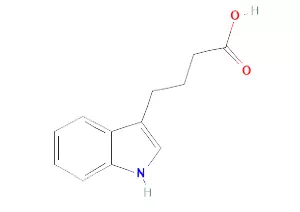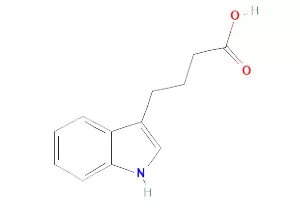All Categories


indole-3-Butyric acid CAS 133-32-4, indole-3-Butyric acid, CAS 133-32-4
3-indolebutyric acid, also known as indolebutyric acid or indoleylbutyric acid, has a chemical formula of C11H12O2N and a molecular weight precisely of 190.22.
CAS : 133-32-4
Formula : C12H13NO2
Mol. wt. : 203.24
EINECS : 205-101-5
Chemical Name: | Indole-3-Butyric acid |
Other Name: | 3-Indolebutyric acid; Gamma-(3-indolyl)butyricacid; 1H-indole-3-butanoic acid, IBA |
CAS: | 133-32-4 |
EINECS: | 205-101-5 |
Type: | Plant extracts; Chemical pesticide technical; Inorganic salts; Pharmaceutical, pesticide and dye intermediates; Organic raw materials |
Molecular Formula: | C12H13NO2 |
Molecular Weight: | 203.24 |

Melting point | 124-125.5 °C(lit.) |
Boiling point | 341.55°C (rough estimate) |
bulk density | 360kg/m3 |
density | 1.1255 (rough estimate) |
refractive index | 1.5440 (estimate) |
storage temp. | 2-8°C |
solubility | DMF: 25 mg/mL; DMSO: 25 mg/mL; Ethanol: 25 mg/mL; PBS (pH 7.2): 0.1 mg/mL |
pka | 4.83±0.10(Predicted) |
form | Liquid |
color | Clear colorless to pale yellow |
Water Solubility | Soluble in water(0.25g/L). |
Sensitive | Air Sensitive |
3-indolebutyric acid, also known as indolebutyric acid or indoleylbutyric acid, has a chemical formula of C11H12O2N and a molecular weight precisely of 190.22. When in a pure state, this compound presents as a white crystalline solid and melts within a specific temperature range, namely 124 to 125 degrees Celsius. The 3-indolebutyric acid products obtained in the industrial production process may appear as white or light yellow crystals, and their melting points are slightly different, approximately ranging from 121 to 124 degrees Celsius.
This substance has a unique smell. At the same time, it is regarded as toxic and irritating. At 60 degrees Celsius, its vapor pressure is less than 10 micropascals. 3-indolebutyric acid is almost insoluble in water. Specifically, in water at 20 degrees Celsius, its solubility is only 0.25 grams per liter. However, it can be easily dissolved in benzene and also in other organic solvents. For example, its solubility in benzene is extremely high (measured in grams per 100 milliliters), while its solubility in acetone, ethanol and ether ranges from 3 to 10 grams per 100 milliliters. The solubility in chloroform is negative (indicating data deficiency).
For humans and animals, the toxicity of 3-indolebutyric acid is relatively low. This compound shows stability in acidic environments, but under alkaline conditions, such as in solutions of alkali metal hydroxides or carbonate compounds, it forms corresponding salts. From a synthetic perspective, 3-indolebutyric acid can be prepared by the reaction of indole with Grignard reagent or by the hydrolysis of nitriles.
In the agricultural field, 3-indolebutyric acid is widely used as a plant growth promoter, especially excelling in promoting root development and accelerating the fruit ripening process. Compared with another commonly used plant hormone - indoleacetic acid, the effect of 3-indolebutyric acid is more significant. In particular, during the process of cherry rootstock cutting propagation, 3-indolebutyric acid is a very effective rooting promoter. To enhance the success rate of cuttings, a high-concentration rapid soaking method can be adopted to treat the bottom of the cuttings. That is, the base of the cuttings should be immersed in an IBA solution with a concentration range from 5×10^-4 to 1×10^-2 moles per liter for about 5 seconds, and then immediately inserted into the seedling soil. This method is not only simple and quick to operate and can ensure the uniform distribution of the drug, but also can achieve good results. If an additional dose of 20.375 grams per square meter of simmazine is added to the cutting bed, the rooting rate can be further improved.
In the application of plant growth regulators, a common and effective method is to treat plants with a liquid concentration ranging from 0.001% to 0.0001%. This treatment method has a remarkable effect on promoting the rooting of various tree and flower cuttings. It not only accelerates the development of the root system but also increases the survival rate, thus playing an important role in the cultivation of seedlings and large-scale reproduction. It is worth noting that when using this type of regulator, it should be avoided to spray or apply it directly to the plant leaves to prevent unnecessary damage.
Among them, indolebutyric acid (IBA), as a widely used indole plant growth regulator, is renowned for its outstanding root-promoting properties. It can not only effectively promote the rapid rooting of herbaceous and woody ornamental plants through cuttings, but also be used to increase fruit yield, optimizing crop output by improving fruit setting rate. IBA is recognized as a safe and pollution-free biochemical agent due to its high efficiency, low toxicity, strong activity and wide applicability, and plays an important role in agricultural production.
Further studies have shown that the synthetic form of indole-3-butyric acid exhibits extremely high efficiency and safety, making it one of the indispensable tools in modern agricultural production. As a high-quality plant growth regulator, rooting agent and fruit and vegetable growth promoter, it has shown great potential in improving the quality and quantity of crops.
Furthermore, from a biological perspective, indole-3-butyric acid belongs to a member of the plant hormone family. Specifically, it is the precursor substance of indole-3-acetic acid (IAA). IAA, as one of the most abundant auxin in nature, undertakes most of the functions related to growth and development in intact plants and is regarded as one of the most effective natural growth factors. This means that by making rational use of synthetic products like IBA, the IAA level in plants can be indirectly supplemented, thereby enhancing their overall health and productivity.
* Prompt reply and 24 hours online, professional team to provide best price and high quality product.
* Sample testing support.
* Every batch of products will be tested to ensureits quality.
*The packing also can be according the customers` requirment.
*Any inquiries will be replied within 24 hours.
*we provide Commerical Invoice, Packing List, Bill of loading, COA , Health certificate and Origin certificate. If your markets have any special requirements, let us know.